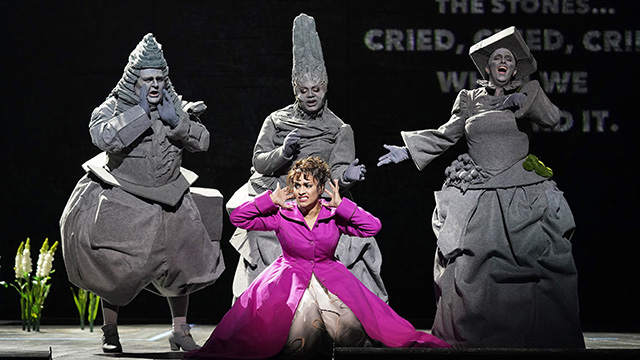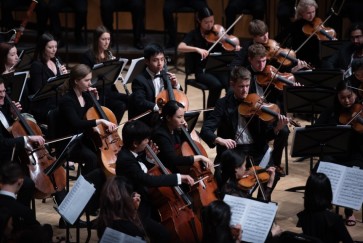Award-winning costume designer Ana Kuzmanic, associate theater professor in the School of Communication, provides an insight into the creative process of mounting a world premiere opera.
For centuries, the myth of Orpheus and Eurydice has fueled the imaginations of artists, yielding famous adaptations by composer Claudio Monteverdi, filmmaker Jean Cocteau, playwright Tennessee Williams, choreographer Pina Bausch and graphic novelist Neil Gaiman, to name just a few.

The most recent high-profile adaptation is LA Opera’s Feb. 1 to 23 world premiere of “Eurydice” featuring a libretto based on Sarah Ruhl’s 2003 play and music by Matthew Aucoin. The production was directed by School of Communication professor Mary Zimmerman and features costumes by Northwestern theater faculty Kuzmanic (MFA ’04) and set design by alumnus and former faculty Daniel Ostling (MFA ’96).
The standard telling of the myth focuses on Orpheus, a demi-god with a musical gift so powerful, his harp playing allows Jason and the Argonauts to pass safely by sirens. When Orpheus’ bride Eurydice dies on their wedding day, he travels to the underworld and uses song to convince Hades to release Eurydice back to the world of the living. But Orpheus fails to follow Hades’ condition to not look backwards as they leave and causes Eurydice to die again and return to the underworld for eternity.
Ruhl’s adaptation focuses on Eurydice’s point of view, and adds the character of Eurydice’s father — already dead — to the story. As the deceased pass into the underworld they must pass through the waters of forgetting, but Eurydice’s father has somehow retained his memory. When his daughter descends the underworld, tragically, she mistakes him for a bellhop. Ruhl mines the myth for themes of familial relationship and the experience of loss and remembering.

Zimmerman, the Jaharis Family Foundation Chair in Performance Studies, is no stranger to mythology. Zimmerman won a Tony Award for her aquatic adaptation of Ovid’s “Metamorphoses,” which had its original workshop production at Northwestern. Opera collaborator Aucoin also is well versed in the myth. His previous composition work includes “Orphic Moment,” a cantata focused on Orpheus’s dark moments before looking back.
Zimmerman approached her Northwestern peers Kuzmanic and Ostling to create the world of the “Eurydice” through costume and set design.
Kuzmanic demystifies the creative process for “Eurydice” in an exclusive Northwestern Q&A:
What ideas informed your approach to costume design?
When working with Mary (Zimmerman), I know her aesthetic will blend the mythical with contemporary references. In our early discussions we talked about love, people falling in love and marrying and how common it is. We wanted the silhouette of Eurydice’s wedding dress to be traditional — almost archetypal. We also talked about grief as a human experience that every individual experiences in a unique way. As time passes, we wanted to show the visible impact of the Underworld on Eurydice. Her dress keeps changing by absorbing the darkness of the Underworld in a way unique to Eurydice and her grief.

In Sarah Ruhl’s stage directions in the libretto it is indicated that the attire is in the style of the 1950s. To highlight the Greek origin of the myth of Orpheus and Eurydice I collaged the patterns from Ancient Greek art pieces onto 1950s inspired clothing. In this way our own world, in which the epic and mythical co-exist with everyday modern, was invented.
What inspired the Stones of the Underworld?
The Stones look down on the Dead and occupy a higher rank in Hades’ posse, so their silhouettes span several centuries and reflect the clothes of court nobility. I was amused by the individual characters of the Stones — which involved malicious traits as well as some good humor. Each Stone has a distinct personality and I wanted the costumes to reflect that. The Little Stone has pebbles sprinkled all over, since those are usually tiny in scale. On the contrary the Big Stone’s headpiece resembles a tall cliff to emphasize her grandiosity.
What was the trickiest problem to solve in the design process?
In opera, the mobility of the singers is very important. The character of Hades was a great challenge of engineering because he dons an oversized tail and walks on stilts. The music, composed by Matt Aucoin, is quite unusual and emphasizes Hades’ desire to appear human. One of my tasks was to assign his character a color that is unique. Hades eats away at the living and so acid green seemed appropriate (see photo above). It is a simple choice, but for a designer, the road to those simple choices is usually quite elaborate and involves multiple series of sketches, drawings and painted works.
Why are artists so attracted to myths like Eurydice and Orpheus?
I think the reason why we keep going back to those old myths and legends is because these themes are universal. The Myth of Orpheus and Eurydice may have originated in Ancient Greece but the themes of fighting for love and losing a loved one are eternal and surpass boundaries, languages and cultures.
Following LA Opera’s world premiere, “Eurydice” is slated for a New York premiere at the Metropolitan Opera in 2021.
Other upcoming and recent Northwestern treatments of the tale include:
- Bienen School of Music will present Monteverdi’s opera “Orfeo” May 21 to 24 at Cahn Auditorium.
- Tony and Grammy Award-winning musical “Hadestown,” currently running on Broadway, is company managed by ’84 School of Communication graduate Kim Kelley.
- MFA directing candidate Hamid Dehghani directed Ruhl’s play “Eurydice” for the Winter 2020 MFA Lab production.


